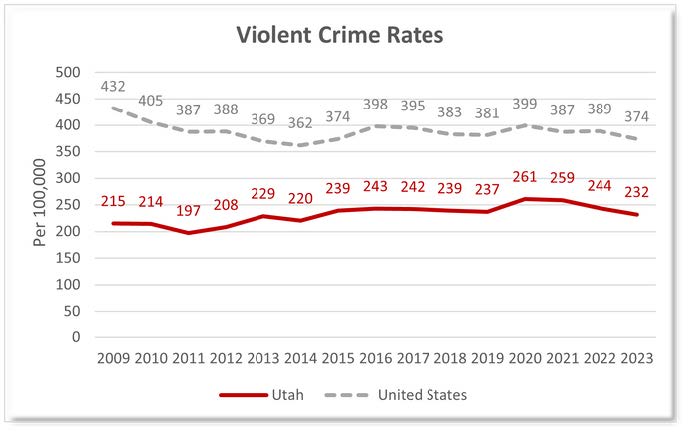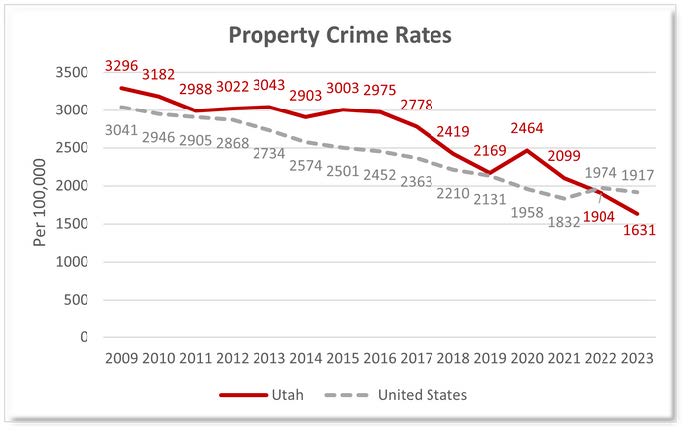Criminal Justice Research Summary
Criminal Justice Research Summary
Crime Trends
Violent crime rates have decreased substantially, both nationally and in Utah, from historic highs. There was a rise in violent crime in the post-Covid era but it has begun to decline again since 2022. Property crime rates have experienced even steeper drops.1

Source: Utah Commission on Criminal & Juvenile Justice
Utah’s violent crime rate in 2023 was 232 per 100,000 residents, which is now lower than the pre-pandemic 2019 rate of 237 (lowest rate since 2014) and shows an 11% decrease from the recent high of 261 seen during the 2020 spike. Apart from 2020 and 2021 (also elevated at 259 per 100,000 population), Utah’s violent crime rate has been fairly stable since 2013. Utah’s violent crime rate is generally a third lower than the national rate.

Source: Utah Commission on Criminal & Juvenile Justice
According to FBI estimates of crimes reported to law enforcement, Utah’s property crime rate in 2023 was 1,631 per 100,000 residents. This is a decrease of 14% over the 2022 rate of 1,904 and is 34% lower than the 2020 property crime rate spike (2,464) amidst the pandemic and social unrest of that year. This 2023 property crime rate is another historic low (this is the third straight year setting record lows). Utah’s property crime rate is now well below the national rate (15% lower) after years of being higher.
Crime prevention approaches rely on some combination of three primary strategies: incapacitation, deterrence, and rehabilitation.
Incapacitation
Incapacitation refers to those strategies that prevent crime by incarcerating individuals who have broken the law.
- Incarceration is associated with time-limited reductions in offending, due to the incapacitation of individuals while they are in prison or jail.2
- Incarceration is not associated with reduced offending in the long-term.2
- Incarceration can increase an individual’s risk of recidivism, due to exposure to environments that model and reward antisocial attitudes and behaviors and desensitization to incarceration once an individual has experienced it.3
- When compared with non-custodial sanctions, such as probation, custodial sanctions have no impact on long-term recidivism.2
Deterrence
Deterrence refers to those strategies that prevent crime by increasing the perceived consequences of breaking the law.
- Increased sentence lengths are not associated with reductions in crime, in part because most individuals do not know the precise consequences for violating the criminal code.5
- Immediacy and certainty of sanctions are more important than their severity for deterring criminal behavior.6
- The certainty of detection/punishment is a crime deterrent. This includes increased police presence in areas that experience higher levels of crime. For example, burglars are more likely to avoid neighborhoods with higher police presence.7
- The solve rates for many types of crime are relatively low. For example, the solve rate for violent crime in Utah is 54%, which means nearly half of individuals who committed a violent crime did not experience the intended punishment.8
Rehabilitation
Rehabilitation refers to those strategies that prevent crime through changing the attitudes,skills, and motivations of those who have committed a crime.
- Treatment programs reduce recidivism when they target identified criminogenic needs: education, employment, antisocial attitudes and values, family and peer relationships, substance use, and isolation from pro-social activities. Programs that do not target these factors have no impact on recidivism.9
- Community supervision is more likely to achieve long term behavioral change when combined with evidence-based treatment interventions and when supervision activities focus on ensuring compliance with treatment goals.9
